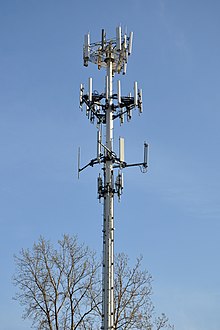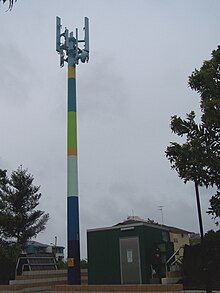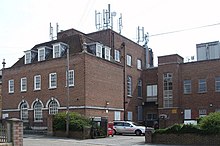Cell site: Difference between revisions
Trim non contributing prose, etc |
|||
| Line 60: | Line 60: | ||
=== Off Grid Systems === |
=== Off Grid Systems === |
||
There are several exemples of |
There are several exemples of '''cell sites''' that can work off grid (that is without electrical power from the grid). |
||
[[Fuel cell]] [[backup power]] systems are added to critical cell sites to provide emergency power. More sites use internal-combustion-engine-driven generator sets.<ref>[http://fr.chfca.ca/itoolkit.asp?pg=BALLARD_07132009 Ballard fuel cells to power telecom backup power units for motorola]</ref><ref>[http://cleantech.com/news/3674/india-telecom-get-fuel-cells India telecoms to get fuel cell power]</ref> |
[[Fuel cell]] [[backup power]] systems are added to critical cell sites to provide emergency power. More sites use internal-combustion-engine-driven generator sets.<ref>[http://fr.chfca.ca/itoolkit.asp?pg=BALLARD_07132009 Ballard fuel cells to power telecom backup power units for motorola]</ref><ref>[http://cleantech.com/news/3674/india-telecom-get-fuel-cells India telecoms to get fuel cell power]</ref> |
||
In areas where the radio base stations cannot be connected to the grid are generally powered by systems such as power generators. This solution, in addition to being a source of pollution (atmospheric, acoustic, etc.) is often used in areas protected by environment and landscape conservation and represents a burden on the operative costs (opex). |
In areas where the radio base stations cannot be connected to the grid are generally powered by systems such as power generators. This solution, in addition to being a source of pollution (atmospheric, acoustic, etc.) is often used in areas protected by environment and landscape conservation and represents a burden on the operative costs (opex). |
||
Revision as of 07:31, 5 September 2011







A cell site is a term used to describe a site where antennas and electronic communications equipment are placed, usually on a radio mast, tower or other high place, to create a cell in a cellular network. The elevated structure typically supports antennas, and one or more sets of transmitter/receivers transceivers, digital signal processors, control electronics, a GPS receiver for timing (for CDMA2000/IS-95 or GSM systems), primary and backup electrical power sources, and sheltering.[1]
A cell site is sometimes called a "cell tower", even if the cell site antennas are mounted on a building rather than a tower. In GSM networks, the technically correct term is Base Transceiver Station (BTS), and colloquial British English synonyms are "mobile phone mast" or "base station". The term "base station site" might better reflect the increasing co-location of multiple mobile operators, and therefore multiple base stations, at a single site. Depending on an operator's technology, even a site hosting just a single mobile operator may house multiple base stations, each to serve a different air interface technology (CDMA2000 or GSM, for example).
Some cities require that cell sites be inconspicuous, for example blended with the surrounding area. Preserved treescapes can often hide cell towers inside an artificial tree or preserved tree. These installations are generally referred to as concealed cell sites or stealth cell sites.
Operation
Range
The working range of a cell site - the range within which mobile devices can connect to it reliably - is not a fixed figure. It will depend on a number of factors, including
- The frequency of signal in use (i.e. the underlying technology).
- The transmitter's rated power.
- The required uplink/downlink data rate of the subscriber's device [2]
- The transmitter's size.
- The array setup of panels may cause the transmitter to be directional or omni-directional.
- It may also be limited by local geographical or regulatory factors and weather conditions.
Generally, in areas where there are enough cell sites to cover a wide area, the range of each one will be set to:
- Ensure there is enough overlap for "handover" to/from other sites (moving the signal for a mobile device from one cell site to another, for those technologies that can handle it - e.g. making a GSM phone call while in a car or train).
- Ensure that the overlap area is not too large, to minimize interference problems with other sites.
In practice, cell sites are grouped in areas of high population density, with the most potential users. Cell phone traffic through a single cell mast is limited by the mast's capacity; there is a finite number of calls or data traffic that a mast can handle at once. This limitation is another factor affecting the spacing of cell mast sites. In suburban areas, masts are commonly spaced 1–2 miles (2-3 km) apart and in dense urban areas, masts may be as close as ¼-½ mile (400-800 m) apart. Cell masts always reserve part of their available bandwidth for emergency calls.
The maximum range of a mast (where it is not limited by interference with other masts nearby) depends on the same circumstances. Some technologies, such as GSM, normally have a fixed maximum range of 35 kilometres (22 mi), which is imposed by technical limitations. CDMA and IDEN have no built-in limit, but the limiting factor is the ability of a low-powered personal cell phone to transmit back to the mast. As a rough guide, based on a tall mast and flat terrain, it is possible to get between 50 to 70 km (30–45 miles). When the terrain is hilly, the maximum distance can vary from as little as 5 kilometres (3.1 mi) to 8 kilometres (5.0 mi) due to encroachment of intermediate objects into the wide center fresnel zone of the signal.[3] Depending on terrain and other circumstances, a GSM Tower can replace between 2 and 50 miles (80 km) of cabling for fixed wireless networks.[4]
Channel reuse
The concept of "maximum" range is misleading, however, in a cellular network. Cellular networks are designed to create a mass communication solution from a limited amount of channels (slices of radio frequency spectrum necessary to make one conversation) that are licensed to an operator of a cellular service. To overcome this limitation, it is necessary to repeat and reuse the same channels at different locations. Just as a car radio changes from one local station to a completely different local station with the same frequency when you travel to another city, the same radio channel gets reused on a cell mast only a few miles away. To do this, the signal of a cell mast is intentionally kept at low power and many cases tilting downward to limit its area. The area sometimes needs to be limited when a large number of users are near a particular mast; the range of this mast has to be limited so that it covers an area small enough not to have to support more conversations than the available channels can carry. Due to the sectorized arrangement of antennas on a tower, it is possible to vary the strength and angle of each sector depending on the coverage of other towers in view of the sector.
A cellphone may not work at times, because it is too far from a mast, or because the phone is in a location where there is cell phone signals are attenuated by thick building walls, hills or other structures. The signals do not need a clear line of sight but the more interference will degrade or eliminate reception. Too many people may be trying to use the cell mast at the same time, e.g. a traffic jam or a sports event, then there will be a signal on the phone display but it is blocked from starting a new connection. The other limiting factor for cell phones is the ability of the cell phone to send a signal from its low powered battery to the mast. Some cellphones perform better than others under low power or low battery, typically due to the ability to send a good signal from the phone to the mast.
The base station controller (a central computer that specializes in making phone connections) and the intelligence of the cellphone keeps track of and allows the phone to switch from one mast to the next during conversation. As the user moves towards a mast it picks the strongest signal and releases the mast from which the signal has become weaker; that channel on that mast becomes available to another user.
Geolocation
Cellular geolocation is less precise than by GPS, but it is available to devices that do not have GPS receivers and where the GPS is not available. The precision of this system varies widely. Precision is highest where advanced forward link methods are possible (where a device is within range of at least three cell sites and where the carrier has implemented timing system use) and lowest where only a single cell site can be reached, in which case the location is only known to be within the coverage of that site. Another method using angle of arrival (AoA), possible when in range of at least two cell sites, produces intermediate precision. In the United States, for emergency calling service using location data (locally called "Enhanced 911"), it was required that at least 95% of cellular phones in use on 31 December 2005 support such service. Many carriers missed this deadline and were fined by the Federal Communications Commission.[5]
Radio power and health
The U.S. government agency, the FCC, says:
"For example, measurement data obtained from various sources have consistently indicated that "worst-case" ground-level power densities near typical cellular towers are on the order of 1 µW/cm2 or less (usually significantly less)." [citation needed]
Different kind of cell sites
Temporary set-up


Although cell antennas are normally attached to permanent structures, carriers also maintain fleets of vehicles, called cells-on-wheels (COWs), that serve as temporary cell sites. A generator may be included for use where network electrical power isn't available, and the system may have a wireless backhaul link allowing use where a wired link is not available.
COWs are also used at permanent cell sites—as temporary replacements for damaged equipment, during planned outages, and to augment capacity such as during conventions.
Off Grid Systems
There are several exemples of cell sites that can work off grid (that is without electrical power from the grid). Fuel cell backup power systems are added to critical cell sites to provide emergency power. More sites use internal-combustion-engine-driven generator sets.[6][7] In areas where the radio base stations cannot be connected to the grid are generally powered by systems such as power generators. This solution, in addition to being a source of pollution (atmospheric, acoustic, etc.) is often used in areas protected by environment and landscape conservation and represents a burden on the operative costs (opex). Renewable energy can be applied for reliability and energy autonomy.
This solution in addition to being ecologically correct, is based on innovative technical solutions that render it economically competitive in respect to traditional power systems.
Camouflage
There is often local opposition to new masts for reasons of safety and appearance. The latter is sometimes tackled by disguising the mast as something else, such as a flag pole, street lamp, or a tree (i.e. palm trees, pine trees, cypress..) or rooftop structures or urban fornitures such as chimneys or panels.
These concealed cell sites can distinguish themselves by foliage shape and bark type. The foliage of all these antennas is composed of leaves made of plastic material accurately designed, taking into consideration quantity, shape and array suitable to completely conceal the antennas and all accessory parts in a natural manner. The materials used, in addition to guaranteeing absolute radio-electric transparency and resistance to UVA rays. Nicknames include "monopalm" for a monopole disguised as a palm tree or "Pseudpinus telephoneyensis" for a mast disguised as a pine tree.[8] In monopoles, the directional antennas are sometimes hidden in a plastic housing near the top of the pole so that the crossbars can be eliminated.
Rooftop structures such as concealment chimneys or panels, 6 to 12 meters high, may conceal one or more mobile telephone operators on the same station. Roofmask panels can be fixed to existing rooftop structures, restyling them quickly and cheaply.
Mobile telephone base stations are becoming a contemporary symbol, connected and intertwining with material and immaterial networks. Telestyles are architecturally blended cell towers, the result of cooperation with designers and architects.
See also
- Cellular network
- Node B
- OpenBTS
- Mobile phone radiation and health
- Telecom infrastructure sharing
- Concealed cell sites
- Base transceiver station
- Radio masts and towers
- Mobile cell sites
References
- ^ Learn about what is on a cell tower: Without the Cat undated, URL retrieved 09 December 2010.
- ^ J. Andrews, A. Gohsh (2007). Fundamentals of WiMAX, p. 43
- ^ Frequently Asked PCS Questions undated, URL retrieved 14 August 2007.
- ^ NTIA Seeks Input on Broadband Stimulus Money undated, URL retrieved 3 March 2009.
- ^ http://www.fiercewireless.com/story/sprint-alltel-usc-fined-missed-e911-deadline/2007-08-31
- ^ Ballard fuel cells to power telecom backup power units for motorola
- ^ India telecoms to get fuel cell power
- ^ http://www.watsonia.org.uk/BSBINews80.pdf
External links
- Maps of All Towers Across the United States
- Searchable map of cell (and all other) towers in Australia
- FCC: Universal Licensing Information
- FCC: Information On Human Exposure To Radio frequency Fields From Cellular and PCS Radio Transmitters
- Australian Radiation Protection and Nuclear Safety Agency (ARPANSA) Base Station Survey 2007- 2011
